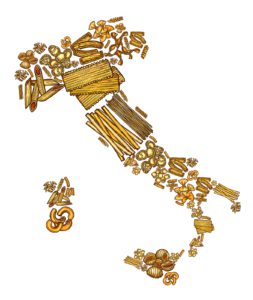Italian Cuisine
Authentic Italian Food
An Introduction to Italy – Geography and Culture
Italy! The name alone conjures up images of gorgeous countryside, iconic food, cities filled with centuries-old art, and a culture that embraces the past, seamlessly weaving it into daily modern life.
In this series of articles, we take you on a journey through Italy’s unique heritage and diverse culture while exploring its renowned cuisine that includes wine, pasta, pizza, cheese, and polenta.
“If your mother cooks Italian food, why should you go to a restaurant?” – Martin Scorsese
Geography of Italy
The 72nd largest country in the world, Italy’s total area is 116,350 square miles. It measures 736 miles from its most northern point to its southern tip in the Mediterranean Sea, with a width of 237 miles between the Mediterranean Sea and the Adriatic Sea. Italy is approximately the size of Arizona; going from north to south is the equivalent of driving from the northernmost part of California to San Diego, taking just over 12 hours. Italy has approximately 61,000,000 residents, making it the 23rd most populous country in the world.
Almost 40 percent of Italy is mountainous, which has had an impact on the country’s political geography. Before roads were created and paved, the rugged landscape made travel between towns difficult. As a result, they were historically cut off from one another, resulting in self-sufficiency, independence, and a little mistrust of outsiders. That explains why the cuisine and dialect spoken can vary so much from one town to the next, even though they are not far apart.
The Difference between Northern & Southern Italy
The entire area north of Rome is known as northern Italy. It has a large concentration of industrial areas, producing as much as 90% of Italy’s exports. Although there is no official designation of “north” and “south,” each part of the country is distinctly different from the other. Whereas northern Italy has neighbors to the north, east, and west, the south has no land borders, making it more influenced by the surrounding sea as well as more isolated.
Although the country was unified in 1861, Italians tend to retain their unique regional identity. The population of northern Italy is primarily Germanic, Celtic, and French, while southern Italians can trace their heritage to the Arabs, Greeks, and Spanish who once ruled over the region. Because of the differences among the people, history, landscape, and weather of the north and south, it is possible to make a few generalizations about how the culture and cuisine of each diverge.
Cuisine: Northerners’ diet is rich, starchy, and hearty. Because the land is ideal for raising cattle, cheeses, and meat prevail. Southern cuisine is more about the sea and the sun, with lots of fresh seafood, tomatoes, eggplants, and herbs – hence, the invention of pizza in Naples! Foods get more exotic as you go south, with chickpeas stews and risottos reflecting a taste of North Africa. And lots of olive oil!
Culture: Northern Italians are often thought to be hard-working and business-oriented due to the expansive industrialization of the north, whereas southerners are considered more laid back. Southern Italy is more traditional and rustic.
Economy: While Italy’s economy is the ninth largest in the world, services and manufacturing are concentrated in the north. As a result, there is a big difference in living standards between the north and the south.
How is Italy Divided?
Italy is divided into 20 “ragioni,” or administrative regions. They are scattered among the country’s four parts: the north, the south, the center, and the islands. In the north you’ll find Piedmont, which encompasses Milan; Liguria, stretching along the Mediterranean coast to Genoa; the agricultural area of Lombardy that is now an industrial center; and Veneto, which reaches from Brescia to Venice, home to the Venetian empire.
Many well-known cities and towns are located in central Italy, particularly Tuscany and Umbria, a favorite of tourists, known for their traditions of art and culture, and Campagna, which is home to Rome, the “Eternal City.” Southern Italy consists of Mezzogiorno, where you will find Naples, and Puglia, which forms the “heel” of Italy on its map. Finally, there are the islands of Sicily and Sardinia, whose populations remain fiercely independent.
Bottom of Form These 20 regions play a major role in Italian identity. Each one is unique, with a distinctive landscape and its own particular cuisine and culture. Italians often identify themselves by their region, so for instance, they might consider themselves Venetian or Neopolitan rather than Italian. Although the country’s official language is Italian, each region has its own dialect, which to the untrained ear sounds nothing like the mother tongue, and which changes every few kilometers. As a result, a northern Italian may not be able to understand a southern dialect.
Keep an eye out for more upcoming articles about Italy as we share with you its history, culture, and cuisine.
Find Local Italian Shefs & Pasta Meals
When searching for traditional Italian cuisine, pasta, or classic desserts, you’ll find Shef delivers Italian food in the following locations:
- Los Angeles
- San Francisco (Bay Area)
- Chicago
- New York City
- New Jersey
- Seattle
Find your local home-cooked & authentic food today!











